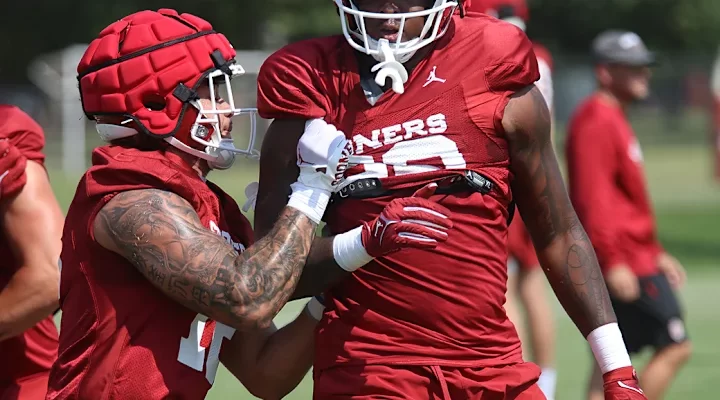Brent Venables Sees a Game-Changing Edge in Oklahoma’s Revamped Tight End Unit
When Brent Venables returned to Norman to lead the Oklahoma Sooners, his vision extended beyond rebuilding a defense or sharpening an offense. He wanted to instill a complete culture shift—one that would bring Oklahoma back to the national stage as a balanced, physical, and strategically dynamic powerhouse. A key component of this vision, though perhaps underappreciated outside coaching circles, is the transformation of the tight end position. Venables has made no secret of his excitement about the Sooners’ tight end room this season, describing it as “completely different” from past years—and he means that in the best way possible.
The tight end position has long been one of football’s most versatile roles, a position where blocking and receiving converge, demanding intelligence, toughness, and adaptability. For Oklahoma, this position hasn’t always been a central focal point in recent years, particularly during offensive schemes that prioritized spread formations and wide-open passing attacks. But under Venables and offensive coordinator Seth Littrell, the Sooners are re-emphasizing the value of tight ends as both matchup nightmares and foundational blockers for a powerful run game. This strategic shift has not only reshaped the offense but also put Oklahoma in a position to compete against the elite defenses they’ll face in the SEC, where physicality and versatility often define success.
Venables has openly stated that he “really likes” the revamped tight end unit, and for good reason. The combination of returning talent, improved depth, and the addition of new faces with unique skill sets has turned this group into one of the Sooners’ most intriguing weapons. Unlike past seasons where Oklahoma might have leaned on a single standout player or used the position sparingly, the 2024-25 team boasts multiple options who can contribute in meaningful ways, creating a dynamic rotation that keeps defenses guessing.
One of the main reasons Venables is so high on this group is their versatility. He sees in them the ability to line up in various formations and execute multiple roles without tipping the offense’s hand. Tight ends who can block like offensive linemen yet run routes like wide receivers are invaluable in today’s game. They can create mismatches against linebackers who can’t keep up with them in coverage or safeties who lack the physicality to handle them in the run game. Venables has pointed out that this tight end unit is not just bigger and stronger, but also faster and more athletic than what Oklahoma has fielded in recent years. This gives Littrell a plethora of creative options when designing plays that exploit weaknesses in opposing defenses.
Depth is another factor fueling Venables’ enthusiasm. In college football, depth at every position is crucial, but it’s often overlooked at tight end. Injuries, blocking assignments, and the demanding nature of the position mean teams need more than one reliable option. Oklahoma now has a tight end room that Venables believes can go three or four deep without a significant drop in performance. This is a stark contrast to some previous seasons where the Sooners leaned heavily on one or two players, limiting flexibility. Having a deep rotation also means Oklahoma can adjust to different game plans, whether they need a dominant run-blocking presence, a field-stretching receiver, or a hybrid of both.
Another element that excites Venables is the mindset shift within this unit. He has often talked about building a team culture that thrives on toughness and selflessness, and the tight ends embody that philosophy. Unlike some skill positions that thrive on highlight-reel plays, tight ends often do the dirty work—chipping defensive ends, sealing edges, and creating lanes for running backs. Venables has praised the willingness of this group to embrace those responsibilities while also stepping up as reliable pass-catching threats. The balance of grit and finesse in this unit is exactly what he believes will make them indispensable this season.
From a strategic standpoint, the tight end resurgence also aligns with Venables’ long-term plan to prepare Oklahoma for life in the SEC. In the Big 12, offenses have historically thrived on wide-open, high-scoring affairs, often leaning on three or four wide receiver sets. While this approach has its merits, Venables knows that the SEC demands a more physical brand of football. Defenses are faster, stronger, and more disciplined, and the ability to dictate matchups with tight ends can be the difference between a stalled drive and a touchdown. By developing a tight end unit that can excel in both blocking and receiving, Venables is giving Oklahoma a critical advantage in adapting to their new conference.
Players within the group have also earned Venables’ praise for their development during the offseason. Strength and conditioning have been key areas of focus, with the coaching staff emphasizing improved blocking technique, route running, and overall football IQ. Venables has pointed out that the growth of this unit is not just physical but mental. Understanding defensive schemes, reading coverage, and adjusting routes on the fly are all skills that elevate a tight end from good to great. This attention to detail has been evident in spring practices and fall camp, where the tight end unit has consistently stood out as one of the most improved position groups.
While Venables has been careful not to single out individual players too often, the competition within the tight end room is fierce, and that’s exactly how he wants it. Healthy competition breeds excellence, and each player knows they need to bring their best every day. Whether it’s a veteran looking to solidify his role or a younger player eager to make his mark, the collective energy and determination have elevated the entire group. Venables has expressed that this kind of internal competition is what creates championship-caliber teams.
The evolution of the tight end unit is also expected to have a ripple effect on Oklahoma’s offense as a whole. With stronger blocking on the edges, the Sooners’ running game should flourish, creating more opportunities for explosive plays. At the same time, the ability to use tight ends as reliable pass catchers adds another dimension to the passing game, forcing defenses to account for every area of the field. Quarterbacks will have a security blanket in the middle of the field, and offensive coordinators will have the freedom to design creative plays that exploit mismatches.
Venables’ excitement about this group is not just talk. It reflects a larger philosophy of building a team that is complete and unpredictable. In recent years, Oklahoma’s offense has been explosive but at times one-dimensional, relying heavily on star quarterbacks and wide receivers to outscore opponents. By reintroducing the tight end as a key component of the offense, Venables is ensuring the Sooners can win in multiple ways—whether through a bruising ground game, a precise aerial attack, or a combination of both.
Moreover, the “completely different” nature of this tight end unit also speaks to Venables’ recruiting efforts. Bringing in players who fit his vision of toughness, athleticism, and versatility is no small feat. Tight ends who can excel in all facets of the game are rare, and Venables has made it a priority to find and develop those players. The current group reflects that commitment, with a mix of homegrown talent and carefully selected recruits who bring unique skills to the table.
As the season approaches, all eyes will be on how this revamped tight end unit performs when the lights are brightest. It’s one thing to look good in practice, but Venables and his staff believe this group is ready to shine in game situations. Whether it’s making a critical block on a fourth-and-one or catching a touchdown in the red zone, the tight ends will play a pivotal role in determining Oklahoma’s success.
The renewed emphasis on tight ends also has the potential to set Oklahoma apart in recruiting battles. Prospective players watching the Sooners this season will see a team that values and utilizes tight ends in a way that prepares them for the NFL. This could be a game-changer in attracting elite talent at the position, further strengthening Oklahoma’s roster for years to come.
For Venables, the excitement surrounding the tight end unit is part of a bigger picture. He’s not just building a team for this season but laying the groundwork for sustained success. A strong tight end group is a reflection of a balanced offense, one that can adjust to any opponent and thrive under any conditions. It’s a testament to the coaching staff’s ability to adapt and innovate, ensuring that Oklahoma remains competitive at the highest level.
As the Sooners embark on this new chapter, with the SEC looming and the pressure mounting, Brent Venables’ confidence in his tight end unit sends a clear message: Oklahoma is evolving. They are not content with past successes or stuck in old ways of thinking. Instead, they are building a program that can outthink, outwork, and outmuscle its opponents. The “completely different” tight end unit is more than just a position group—it’s a symbol of that transformation, and Venables couldn’t be more thrilled about it.
With a head coach who values every detail, an offensive coordinator ready to unleash creative schemes, and a roster full of hungry, talented players, Oklahoma’s tight ends could very well become the X-factor this season. For Venables, the excitement is not just about potential—it’s about the belief that this group can help the Sooners take the next step toward championship glory. And if the early signs are any indication, this “completely different” tight end unit is ready to prove their coach right in every possible way.


